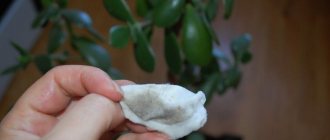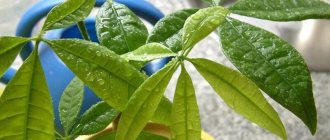It is worth highlighting the main points that cause yellowing of Monstera leaves.
Excess or lack of moisture
An abundance of moisture causes problems with the condition of the plant's leaves . It all starts with the roots, which rot, despite the fact that Monstera removes some of the water through the mouth on its own. To eliminate rotting, you need to reduce the amount of water during watering until the soil dries completely. In particularly advanced cases, replanting the plant and removing damaged roots helps. Monstera is watered after transplantation three days later.
Nutritional deficiencies
Monstera is a tropical plant, so it is important to feed it during growth to compensate for the lack of nutrients. To do this, plant growers adhere to a specially designed soil fertilization schedule.
- In spring - every 2 weeks, fertilize the soil with fertilizers.
- In summer - fertilize the soil with the addition of humus.
Incorrect soil selection
If you purchase a plant in a store, be sure to replant the Monstrela. The soil that is used for plants for sale is filled with a large amount of fertilizers and growth stimulants. If you leave a flower in such conditions, it deteriorates and the leaves turn yellow. When replanting, choose slightly acidic soil or suitable soil from specialists on store shelves.
Dry air
The problem occurs in winter due to the operation of central heating batteries.
Air humidity is reduced to 25%, while for Monstera it is recommended to maintain 60-70%. The problem is solved by spraying with water at room temperature. In some cases, it can be boiled and cooled. Monstera tolerates direct spraying well . The method fits well with the watering schedule.
Incorrect lighting
The organization of light directly affects the condition of Monstera leaves. The plant loves sunlight, but direct rays are dangerous for it. It is necessary to place the pot so that there is enough sun, but without direct lighting on the flower. Windows facing east or west are suitable.
Temperature
Monstera grows well and develops from 16 to 25 degrees Celsius . In other cases, the plant stops growing or grows slowly, the leaves turn yellow and deteriorate. In winter, it is worth maintaining the temperature and not letting it drop below 12 degrees.
Diseases and pests
Monstera is a strong plant and is rarely attacked by pests. But in poor conditions, the main enemies of Monstera are spider mites and mealybugs. They select the undersides of the leaf or its axils. After the attack, the plant stops growing and the leaves turn yellow.
Reasons for yellowing of monstera leaves
The leaves of Monstera selectively turn yellow, which means that it is enough to reduce the watering regime to cope with this problem. When the room temperature is about 16 degrees, it is reduced. Watering in winter is recommended at intervals of 10–15 days. In this case, the water is allowed to stand additionally for at least 24 hours and heated to room temperature. After watering, any remaining water that has leaked into the pan can be drained. If this is not done, the monstera roots will begin to rot and the leaves will turn yellow.
It happens that the plant becomes yellow and lethargic due to a lack of sunlight. During the winter months, it is better to move the pot to a south-facing window sill. Experienced gardeners install lighting lamps near the monstera. In summer, you should choose a more shaded place for this plant, where there are no bright rays. In its natural environment it grows under tall trees. With an abundance of light, the plant easily gets burned. Therefore, you should not place it in summer on southern windows or take it out into the sun without prior preparation.
Leaf blades change color when overmoistened. This phenomenon occurs when the flower is constantly flooded. The cause of yellowing may also be due to an incorrectly selected substrate. The soil must be nutritious and have high breathability. The plant's roots will have difficulty breathing in heavy soil. If the owner floods the monstera, it will begin to wither and rot.
An option would be to transplant into a container with new soil. Dark and yellow leaves are cut off. If only the edges of the sheet have changed color, then only the damaged elements are removed. Damage to monstera leaves can occur due to infestation by harmful insects. The leaves also turn yellow due to a lack of moisture in the soil and the plant itself. In this case, it should be moistened with wet expanded clay scattered on a tray. A container with a plant is placed on it. If the pot is too large, it is recommended to humidify it by placing containers of water in the room.
Maintaining water balance
Watering should be carried out in a precise balance. Any change in one direction leads to the death of the leaf and root system.
From a large influx of water:
- stagnation begins in the pot;
- rot forms;
- a favorable environment is created for the development of pathogenic bacteria.
If disturbances occur in the plant, you should:
- reduce humidity;
- get rid of excess water;
- Allow the soil to dry out so that oxygen can reach the roots.
If the situation is critical, you need to proceed with transplantation and surgical intervention to remove the affected roots. After 3 days, you can start moderate watering.
Lack of moisture in the soil also leads to unfavorable results. Rough lumps of earth compress the rhizomes, useful nutrients are not supplied, which immediately affects the condition of the plant. The small leaves, although they will be tinged with dark green, are so undeveloped that they will no longer please the eye.
Disturbances in the water balance will be shown by the nature of yellowness; brown and brown specks will begin to appear on the formed leaf, which increase over time until they completely destroy it. Young shoots are small and sluggish.
Based on the condition of the soil, you can determine why unsightly changes in the foliage occurred. If the surface of the ground and the perimeter around the pot are covered with cracks, you need to urgently water it and irrigate the leaves with moisture. The order of the water balance should be changed with the onset of the winter season. This is a passive phase for Monstera, accompanied by a reduction in growth, when excess moisture will introduce an imbalance in subsequent development. The affected areas must be disposed of immediately, as they interfere with the full growth of healthy parts.
If additional drying of excessively moist soil is carried out, you need to monitor its surface. A dry crust will cause significant damage to the trunk and roots; timely loosening will eliminate such a defect.
Plant treatment
If a pest is detected, you must try to get rid of it using folk remedies (infusions of onion peels, tobacco or calendula, crushed garlic, a solution of tar or laundry soap). They are less radical and harmful both to the flower itself and to the people living in the apartment. The measure is justified when there are few insects and the plant has not had time to suffer much. Otherwise, it is better to use synthetic insecticides.
Timely treatment will help preserve Monstera
In order for the Monstera to please the owner with its appearance, it is necessary to establish proper care. First of all, it is removed from the draft and protected from accidental damage. You need to carefully select new soil for replanting the vine. The wrong composition is detrimental to the flower. The plant requires regular feeding and watering, diffuse lighting and spraying of leaves.
Establishing proper care
Nasturtium diseases - why leaves turn yellow
Carefully thought out care will ensure the long life of the flower, as well as its abundant growth. To do this, you just need to adhere to the basic principles:
Healthy and lush flower
- proper lighting, namely shaded areas;
- optimal air humidity - at least 60%;
- moderate watering;
- careful selection of soil and sterilization before planting a flower;
- regular fertilizing;
- compliance with quarantine for new plants and timely treatment.
By periodically inspecting house plants, you can recognize an incipient disease in the shortest possible time or organize care for your monstera. Only if the basic principles are observed, Monstera will delight you with an abundance of large and beautiful green leaves.
Why do monstera leaves turn black and what to do with the plant
Monstera's leaves often turn yellow if it is not satisfied with the amount of light or moisture.
The plant is usually placed on or near a windowsill on the southwest or southeast side so that all leaves receive enough light. The northern window has much less natural light.
If additional illumination with an electric lamp is not provided, the plant will lose its rich green color and growth will slow down. But direct sunlight is also dangerous - it can burn.
Leaves turn yellow if the air in the room is dry. On a hot day, the monstera does not need to be watered more often: the roots consume less moisture; they need to be sprayed with clean warm water and wiped with a damp soft cloth.
An air humidifier can save the situation; a pot with a plant can be placed on a tray with wet expanded clay or simply placed around a container of water.
Some gardeners wrap aerial roots with wet cloths at high temperatures.
If you water the monstera too often in winter when the air temperature is low, its leaves will turn yellow. Yellowing and loss of turgor will result from placing the pot in a draft. If the soil in the pot is too heavy or it has become muddled because it has not been changed for a long time, the result will be the same - yellowing, slow growth, discolored spots may appear on the leaves.
Lighting mode
If the green leaves begin to turn pale and yellow spots appear, this means that the plant is exposed to excess sunlight, it needs to urgently change its location or close the curtains on a bright day.
It is better to install the liana in openings:
- northern;
- eastern;
- Western.
When exposed to direct sunlight, Monstera foliage first turns yellow, then turns white. To prevent changes, you need to immediately create lighting with diffused rays and pull the curtains over the window. Darkness is also not a solution; the flower does not like distant, darkened corners.
It begins to lack nutrients, causing the leaf:
- becomes less elastic;
- withers;
- turns yellow;
- falls off.
The flower tolerates shade well, but there is no need to overuse it; lesions will immediately begin, which will take a long time to get rid of.
Watering
Before the next watering, the moisture must be completely absorbed. If the top layer of soil is wet, stagnation will form due to the new portion of liquid. The soil at the bottom of the flowerpot clumps into a lump, and the roots rot. Then the yellow leaves are removed, and the monstera is watered less often. For irrigation, use settled or boiled water.
Note! Excessive watering leads to the proliferation of fungal flora, yellowing of leaves and death of the flower.
In summer, the plant is watered more often. If there is not enough moisture, the lower leaves turn yellow. They sink to the bottom and yellow spots may appear. In such cases, the flower is watered 1-2 times a week in small portions. On hot days, the green part is additionally sprayed with a spray bottle. Aerial roots can be placed in a container of water. With good care, Monstera produces large flowers that resemble feces.
Important! If the soil has an unpleasant odor, watering should be reduced . The monstera is left alone for 1-2 weeks. During this period, the substrate must dry completely.
How to choose soil?
The soil is soft, loose, fertile, and is the main source of nutrients and vital elements for any representative of the flora. The liana also needs properly composed soil in order to provide full life support. Specialized stores sell kits with the necessary elements for various types and varieties of plants.
Farmers prepare the composition on their own; for this you will need the following components:
- peat;
- foliage;
- pine needles;
- sand.
The ingredients are thoroughly mixed in a ratio of 1 to 1. Drainage is created at the bottom of the pot, it does not allow excess moisture to accumulate.
The following signs will help determine the incorrect composition:
- care is followed as recommended;
- growth retardation is observed;
- sluggish, sickly appearance.
With proper watering, temperature conditions, no violations in care, when negative factors such as yellowing and wilting of foliage are observed, you should start replanting the Monstera, changing the soil and pot.
Yellowing of leaves followed by drying out
- When monstera foliage not only turns yellow, but also dries , it means your vine is too hot. As a rule, this problem occurs with the beginning of the heating season, when the room temperature rises and the humidity becomes much lower. The same can be observed in the summer heat if the flower is exposed to the rays of the hot sun. The recipe in this case is simple: the vine needs to be moved to a cooler place, away from sunny windows and heating appliances.
- The leaves of the plant may not turn yellow entirely, but only along the edges . Such changes are observed when the monstera is “starving” or the container is too tight. To fix the problem, transplant the flower into a larger pot and feed it with special fertilizer for decorative foliage flowers.
- Yellowing, warping, drying out and falling foliage may be a sign of mealybug or spider mite infestation . To revive the monstera, you need to wipe the plant with a soft cloth or sponge dipped in soapy water. Then wash the plant with warm water and subsequently spray regularly. In case of severe damage, you will have to resort to the help of special chemicals.
Pests
In addition to diseases caused by fungus and insufficient care, monstera can often be attacked by insect pests.
Ivy scale
This pest spreads with great speed on the shoots, adventitious roots and leaves of Monstera. Very often, the scale insect hides on the inner surface of the leaf and looks like a brown plaque that is firmly pressed against the leaf.
Signs of a plant being affected by scale insects are: depressed appearance, loss of decorative qualities, yellowness and loss of leaves. Also, the detection of a sooty fungus that appears on the honeydew produced by the parasite will tell you about the scale insect pests. To eliminate it, wipe the sheet with a cotton pad or a piece of soft cloth soaked in soapy water. Increased humidity with a simultaneous decrease in temperature will help as accompanying factors
With a high degree of damage, it is almost impossible to fight this parasite. You can try removing the affected areas and treating the plant with a systemic insecticide.
Spider mite
This insect mainly lives on the underside of the monstera leaf blade. The harm it causes is the appearance of cobwebs, which dry out the leaf. The presence of spider mites can also be indicated by pale green dots on the leaves, gradually merging into a large spot. Affected leaves turn pale green and then die.
In order to overcome spider mites, Fitoverm is widely used, and to prevent its appearance , the plant should be regularly sprayed with water and kept in a room with humid air.
The opinions of plant care specialists always boil down to the fact that it is easier to carry out preventive measures than to subsequently fight parasites.
Infusions of onion peels, garlic, tobacco dust, and soap solution are used as folk remedies for the control and prevention of spider mites It is allowed to infuse and use all these means at the same time. To create an infusion, dissolve a tablespoon of the product in a three-liter jar of water and leave for two days.
Reasons for yellowing of monstera leaves
This state of the plant can be due to a number of reasons, namely:
- If all the leaves of a plant turn yellow and then gradually turn pale, this can only mean that there is too much light for the plant. Monstera loves shaded places, so if it gets direct sunlight, the flower must be covered with a curtain or moved away from the window.
- If, on the contrary, there is no sufficient lighting, then the vine may completely shed its foliage. If the monstera is in a too dark place, then it must be moved closer to the windows. Otherwise, the plant may leave only a few leaves on the top and discard the rest.
- If yellowness and brown spots appear on the lower leaves of the plant, but the young foliage remains a rich green color, then it is worth reconsidering the amount of watering. It may not be enough for the normal development of the plant and it is worth increasing the amount of moisture.
- If, along with the appearance of yellowing, the leaves of the flower wither and dry out, this may indicate an excess of moisture and damage to the root system of the plant. In this case, it is worth reducing watering and cutting off wilted leaves. If the situation is critical, then you can try to replant the plant into new soil, and during the replanting process you need to remove the rotten roots. The monstera does not need to be watered for three to four days.
- Another factor that provokes the appearance of yellowness may be a lack of nutrients. To remove this reason, you can feed it with ash or nitrogen fertilizers.
If the leaves turn yellow and dry out
In cases where the foliage does not just turn yellow, but gradually dries out, this may indicate too high an air temperature and low humidity. Do not forget that the liana is a tropical plant. Most often, Monstera owners encounter a similar problem with the onset of the heating season. The same situation can happen again in the summer, when the plant is exposed to direct sunlight. In order to protect the flower, it must be moved to a cooler place.
Sometimes the leaves of a plant turn yellow only at the edges. This problem occurs if the flower pot is too small for it or the plant does not receive the required amount of nutrients. In such cases, urgent transplantation into a larger container and fertilizing with suitable fertilizers is necessary.
Another cause of yellow leaves can be pests: mealybugs or spider mites. To resuscitate the flower, the foliage and trunk must be washed with soapy water. Then rinse with clean water, and then carry out regular treatment for prevention. If the plant is severely affected, then special chemicals will have to be used.
Yellowness and wilting of monstera leaves
This problem most often arises in the autumn-winter period, if at low temperatures the owners continue to water the vine abundantly. In such situations, the life processes of the flower are inhibited, and the leaves gradually dry out. To restore the normal development of the plant, it is necessary to adjust the temperature in the room and check for problems with the level of air humidity. Watering volumes should be reduced.
Prevention and troubleshooting
Monstera is an unpretentious, resilient plant. If you are faced with a situation where the plant is still sick and the leaves have turned yellow, it is important to immediately take the following measures :
- find out the reason, check whether there is enough light, water, assess the humidity;
- eliminate all shortcomings, improve the living conditions of Monstera;
- disinfect the pot and replant the plant if necessary;
- develop a watering and feeding schedule.
To prevent and maintain the healthy state of Monstera:
- always inspect the leaves from above and below;
- pay attention to the growth rate;
- Spray the leaves in a timely manner and wipe the dust on their surface;
- Maintain a stable temperature.
An evergreen plant with colorful leaves, Monstera fits perfectly into large office spaces and grows well in the home. With proper care, there are no problems with it. Monstera decorates the interior and has a beneficial effect on the air quality in the room.
Preventive actions
In musty, poorly ventilated rooms, the main deficiencies in the leaves begin to appear. They grow small, the cuts disappear. In winter, various threats are most often formed.
The plant needs significant help:
- bright places;
- humidifying the space;
- ventilation of premises;
- periodic wiping of sheets;
- spraying solutions in the air;
- directing the roots into the ground so that they take root and additionally nourish the vine;
- regular inspection.
The main parasites include:
- scaleworm;
- aphids;
- tick;
- thrips.
Regular preventive examinations will help identify eggs, their laying or the insect itself. You immediately need to arm yourself with a sponge dampened with soapy water to wipe the leaves and begin treating with insecticide - Intav-Vir, Decis.
Homemade recipes will help:
- Onion decoctions from the peel of the fruit.
- Garlic infusions.
- 1 to 1 diluted alcohol with water.
- Soap solution - dilute 20 g of laundry soap shavings in a liter of water.
Monthly fertilizing with mineral fertilizers will help prevent yellowing of the foliage. It should be started in the spring and stopped at the end of autumn. In winter, the flower takes a break from stressful situations. Before the onset of the season, the pots are moved away from the radiators, drafts are removed, and a process of heat exchange is created between surfaces and objects. Water the plant carefully, pour water onto the rim and not onto the stem. The air is humidified with a spray bottle.











